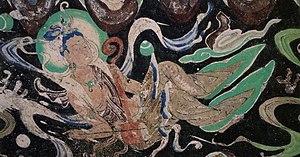
The xiqin (Chinese: 奚琴; pinyin: Xī qín) was a bowed 2-string string musical instrument.[1] The instrument was called xiquin in China, referencing the Xi (the creators, a Mongol tribe) and quin (Chinese for stringed instrument).[2] It is perhaps the original member of the huqin family of Mongolian and Chinese bowed string instruments; thus, the morin khuur and erhu and all similar fiddle instruments may be said to be derived from the xiqin.[2] The xiqin had two silk strings and was held vertically.
- ^ Sadie Stanley, ed. (1984). "Xquin". The New Grove Dictionary of Musical Instruments. Vol. 3. London: MacMillan Press. p. 868.
Xiqin. Historic two-string fiddle of China.
- ^ a b Sadie Stanley, ed. (1984). "Erhu". The New Grove Dictionary of Musical Instruments. Vol. 2. London: MacMillan Press. p. 787.
Erhu...early ancestor known as xiquin...xi; a northern tribe known to the chinese; quin: 'string instrument'...two strings which were set in vibration with a strip of bamboo...